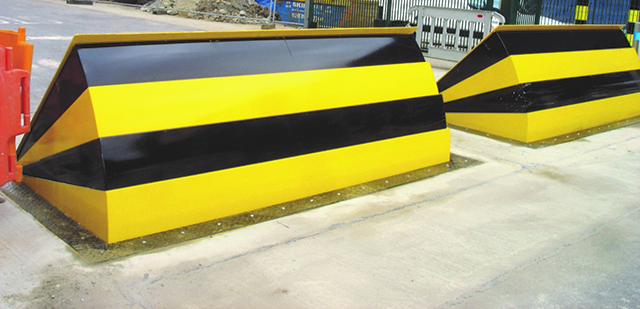Top Guidelines Of Wedge Barriers
Table of ContentsLittle Known Questions About Wedge Barriers.The smart Trick of Wedge Barriers That Nobody is Talking About

The Greatest Guide To Wedge Barriers
The remaining pressure used to
the cam to deploy the wedge plate 16 may be provided offered an electromechanical actuator 84 or other actuator. The springtime assembly 54 and the actuator 84(e. Wedge Barriers. g., electromechanical actuator)may operate together to translate the webcam and raise the wedge plate 16.
As stated above, the springtime setting up 54 applies a consistent pressure on the camera, while the electromechanical actuator may be regulated to apply a variable force on the web cam, consequently enabling the training and lowering( i. e., deploying and retracting )of the wedge plate 16. In particular embodiments, the consistent force applied by the springtime assembly 54 may be adjustable. g., electromechanical actuator) is disabled. As will be appreciated, the springtime assembly 54 may be covered and shielded from particles or other aspects by a cover plate(e. g., cover plate 68 received FIG. 4) that might be considerably flush with the elevated surface 38 of the foundation 14. As discussed above, in the deployed position, the wedge plate 16 serves to block access or travel past the obstacle 10. For instance, the obstacle 10(e. g., the wedge plate 16 )may block pedestrians or cars from accessing a property or path. As talked about above, the obstacle 10 is connected to the anchor 30 safeguarded within the structure 14,

front brackets 71. Therefore, the affiliation settings up 72 might pivot and rotate to enable the collapse and extension of the affiliation assemblies check my reference 72 during retraction and implementation of the bather 10. The linkage settings up 72 reason movement of the wedge plate 16 to be limited. If an automobile is taking a trip in the direction of the released wedge plate 16(e. For example, in one click over here situation, the security legs 86 might be prolonged throughoutmaintenance of the barrier 10. When the security legs 86 are deployed, the safety legs 86 support the weight of the wedge plate 16 versus the surface area 12. Because of this, the lifting mechanism 50 might be deactivated, serviced, removed, replaced, and so forth. FIG. 5 is partial perspective view of a personification of the surface-mounted wedge-style obstacle 10, showing the cam 80 and the cam surface areas 82 of click here to read the lifting mechanism 50. Specifically, 2 webcam surfaces 82, which are referred to as lower web cam surface areas 83, are positioned listed below the camera 80. The lower cam surface areas 83 may be fixed to the surface area 12 (e. As an example, the reduced camera surfaces 83 and the placing plate 85 might form a single piece that is secured to the support 30 by bolts or various other mechanical fasteners. In addition, 2 cam surface areas 82, which are referred to as top webcam surface areas 87, are positioned over the webcam 80 and paired to (e. In various other embodiments, stepping in layers or plates may be placed in between the surface 12 and the reduced webcam surface areas 83 and/or the wedge plate 16 and the upper web cam surfaces 87 As pointed out above, the web cam
80 translates along the webcam surface areas 82 when the wedge plate 16 is lifted from the withdrawed setting to the released setting. In addition, as pointed out above, the spring setting up 54 (see FIG. 3 )may supply a pressure acting on the web cam 80 in the direction 102 by means of springtime rod 58, which may lower the force the electromechanical actuator 84 is needed to relate to the cam 80 in order to actuate and raise the wedge plate 16. 1 )to the released position(see FIG. 4). As shown, the camera 80 consists of track wheels 104(e. g., rollers), which contact and equate along the web cam surfaces 82 during operation.